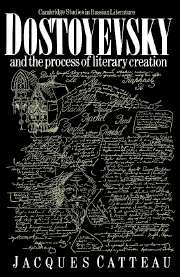Book contents
- Frontmatter
- Contents
- Preface to the English edition
- List of abbreviations
- General editor's note on transliteration and references
- General introduction
- PART I The creative environment
- PART II The process of creation
- Introduction
- 7 The writer at work
- 8 The great dialogue: the news item
- 9 The great dialogue: migrant images
- 10 The play of dialogue
- 11 The unity of thought in the novel
- 12 The summit of creative interrogation: ‘The Life of a Great Sinner’
- 13 A Raw Youth: reasons for choice
- 14 A Raw Youth: the appearance of the vision
- 15 A Raw Youth: the human architecture
- 16 A Raw Youth: the Idea of the novel
- 17 The composition of the novel in Dostoyevsky's work: choice of chronicle form
- 18 Composition of the novel in A Raw Youth: chronicle and stories
- Part III Time and space in the world of the novels
- Conclusion
- Notes
- Select bibliography
- Index of names
9 - The great dialogue: migrant images
Published online by Cambridge University Press: 18 December 2009
- Frontmatter
- Contents
- Preface to the English edition
- List of abbreviations
- General editor's note on transliteration and references
- General introduction
- PART I The creative environment
- PART II The process of creation
- Introduction
- 7 The writer at work
- 8 The great dialogue: the news item
- 9 The great dialogue: migrant images
- 10 The play of dialogue
- 11 The unity of thought in the novel
- 12 The summit of creative interrogation: ‘The Life of a Great Sinner’
- 13 A Raw Youth: reasons for choice
- 14 A Raw Youth: the appearance of the vision
- 15 A Raw Youth: the human architecture
- 16 A Raw Youth: the Idea of the novel
- 17 The composition of the novel in Dostoyevsky's work: choice of chronicle form
- 18 Composition of the novel in A Raw Youth: chronicle and stories
- Part III Time and space in the world of the novels
- Conclusion
- Notes
- Select bibliography
- Index of names
Summary
You want to force humanity not to talk in images … From the very earliest times, man has always talked in images. Every language is full of images and metaphors. You are attacking the expression of thought in images, you are conspirators against progress, you poor unhappy morons.
Dostoyevsky to the ‘destroyers of aesthetics’There is another fruitful and stimulating dialogue in the novels of Dostoyevsky: a dialogue with great living and contemporary literature. The profound realism sustained by assiduous reading of newspapers acquired a new dimension as Dostoyevsky orchestrated a confrontation between the anonymous and factual voice of the crowd and the great voices of literature.
The novel: chosen place of literature
The great ghosts of the past, transformed by Dostoyevsky, continually interrupted and challenged him. As soon as a plan took possession of him, they rose and freely offered their images, characters, even their aesthetic forms. In the very first sketches for The Idiot, Goethe brought forward Mignon, Pushkin Cleopatra from Egyptian Nights, Shakespeare the young, unjustly accused beauty from Much Ado about Nothing, Hero. As soon as Dostoyevsky decided to create a ‘positively good’ hero, Cervantes suggested Don Quixote, Dickens Pickwick, and Victor Hugo Jean Valjean. The Christ of the Gospels, a figure which Renan, mentioned several times in the preparatory notes, was trying to show in more human dimensions, appeared as the great model. During the research, Pushkin contributed The Poor Knight' and Shakespeare Othello, though traces of this appeared only in an unused variant.
- Type
- Chapter
- Information
- Dostoyevsky and the Process of Literary Creation , pp. 193 - 209Publisher: Cambridge University PressPrint publication year: 1989



